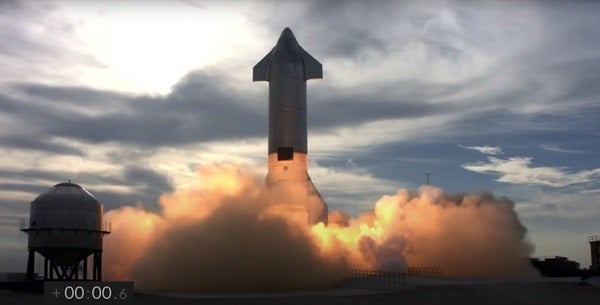SpaceX is no stranger to explosive endings. And yesterday’s high-altitude test flight of the company’s latest Starship rocket prototype, SN10, served as yet another example.
Three hours after a last-second abort scrubbed an initial launch attempt, SN10 ignited its three Raptor engines at around 6:15 p.m. ET on March 3. With the Sun setting in Boca Chica, Texas, Starship climbed into the sky. As intended, SN10 then sequentially shut down its engines as it approached its target altitude of about 6 miles (10 kilometers).
Shortly after T+3 minutes, SN10 cut power to its second engine at an altitude of about 5 miles (8 km), prompting SpaceX engineer John Insprucker — who was narrating the company’s livestream — to call out: “Oh, very nice, very nice.” By T+4 minutes, the rocket had reached its peak altitude, where it hovered for roughly 20 seconds before shutting down its final engine.
As SN10 began dropping from the sky, it reoriented itself from an upright position to a horizontal bellyflop position, allowing two sets of flaps (forward and aft) to stabilize the rocket’s descent.
At about T+6 minutes, SN10’s three engines reignited and helped the craft flip itself back upright. It then shut down two of the engines as it guided itself to the landing pad. At this point in SpaceX’s previous two high-altitude tests, SN8 and SN9, both craft failed to slow down enough to avoid fiery crashes. But this time, SN10 nailed the landing. Well…sort of.
SN10 didn’t immediately detonate on touchdown like its predecessors, which is a win. But it did come in a bit too hard, which caused it to bounce a little before coming to rest in a slightly tilted, though still standing, position.
As a cloud of exhaust around the rocket dissipated, Insprucker called out: “Third time’s the charm, as the saying goes! We’ve had a successful soft touchdown on the landing pad, capping a beautiful test flight of Starship 10.” He went on to remind viewers that “the key point of today’s test flight was to gather the data on controlling the vehicle while reentering, and we were successful in doing so.”
But that was before SN10’s grand finale. At around T+14:40, after SpaceX’s feed concluded, separate livestreams operated by NASA Spaceflight and Everyday Astronaut were caught off guard when SN10 lifted off again — this time thanks to a powerful and unintentional explosion. Though the exact cause of the blast is still under investigation, early reports suggest a methane leak might have been responsible.
The explosion obliterated the SN10 prototype. But fortunately, as Insprucker noted earlier during the stream, the next prototype, SN11, is “ready to roll out on the pad in the very near future.”
You can watch SpaceX’s full coverage of the test flight directly below.











